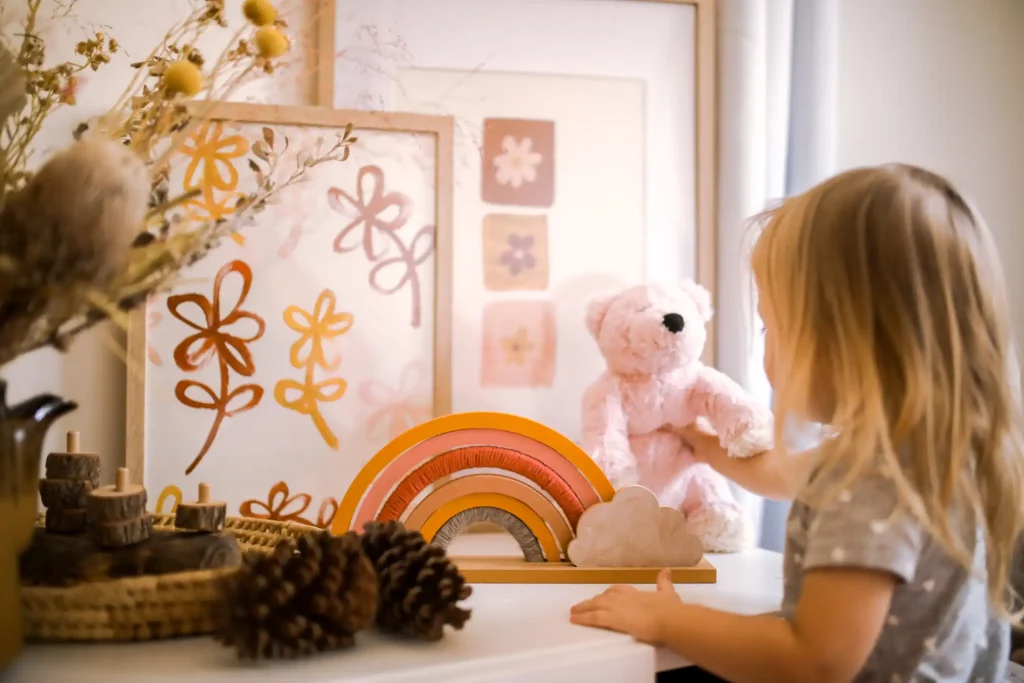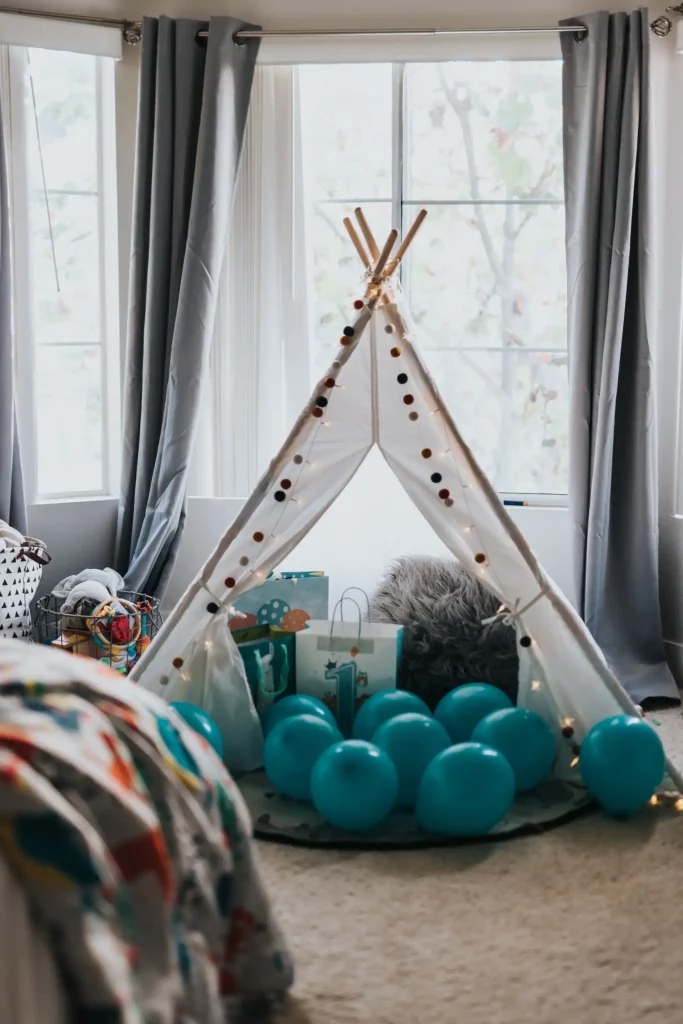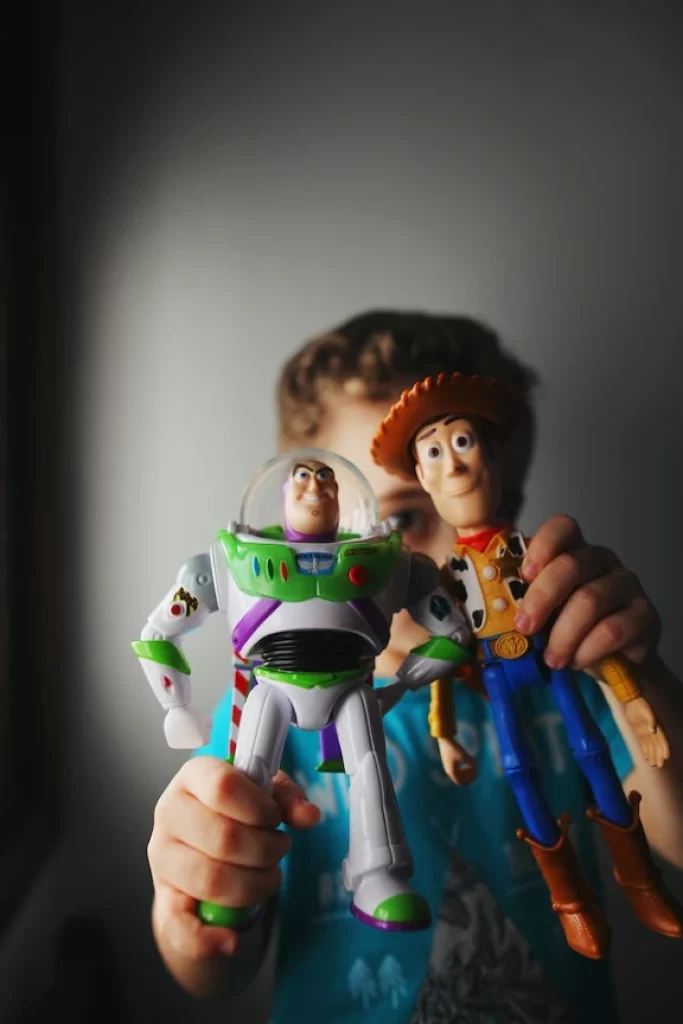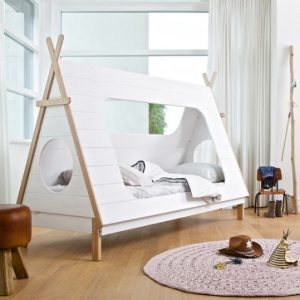
Short Version – Key Points
- Make the bedroom light and airy.
- Make use of all the natural sunlight you have available. If natural light is limited, avoid using dark colours.
- Use soft colour tones for added cosiness. Soft fabrics on pillows and a soft blanket can make them feel cosy.
- Avoid stimulating colours.
- Avoid harsh, fluorescent overhead lighting. White and blue lights in lamps can also hinder sleep.
- Separate the entire room into different zones. A sleep, homework, changing, and play area will keep everything in its place.
- Tidy rooms are less stimulating. Declutter the room.
- Let your children help decorate the room and add their own personal touches.
Long version
Tips and Tricks for a Safe, Cosy, Calming, Anxiety-Free Environment
Making a kid’s room feel safe and secure is one of the most important things you can do as a parent. You want your child to feel comfortable and secure in their own space, and there are many things you can do to achieve this. Read on for warm, welcoming, and anxiety-free bedroom ideas that will give the room a nice, calming, cosy aura!
Create a calm environment:
One of the best ways to make a kid’s room feel safe is to create a calm and relaxing environment. You can do this by personalising the bedroom and using soothing colours, natural furniture, and plenty of soft lighting.
Let’s take a deeper look at each element in order:
Lighting
Plenty of natural sunlight in the room can help make it feel more open and airy, which can help reduce anxiety levels. If your child’s room doesn’t get a lot of natural light, avoid dark tones and opt for softer, lighter colours to help brighten the space.
Plenty of natural sunlight in the room can help make it feel more open and airy, which can help reduce anxiety levels.

Dark colours in a poorly lit room can make it feel small and oppressive, which is the last thing you want for your child. Make the most of any natural light by keeping windows clean and keeping curtains or blinds open during the day.
A room lamp or nightlight can also help create a calming atmosphere and make your child feel safe after dark. Only some children are afraid of the dark; if possible, sleeping without any light is best. However, if your child is anxious, a night light can help your child feel cosy and snug and reassure them if your child wakes during the night; it can also help them get back to sleep.
Use a warm-coloured lamp or nightlight, and keep it dim and away from your child’s bed. You also want to avoid fluorescent strip lights or light bulbs emitting harsh, blue or white light. This type of light has been found to suppress kids’ sleep.
- Avoid Blue Light
- Avoid White Light
- Avoid Fluorescent Strip Lights
Furniture and decoration.
Colour can affect your mood, so it’s important to choose wisely. Softer tones are ideal for relaxation. Soothing colours such as blues, greens, pinks or lighter purples like lavender and lilac have a calming effect and can help to reduce anxiety levels. Avoid energising or stimulating colours like reds or oranges.
Natural wood furniture is also a great choice for a child’s bedroom as it has a calming effect. Make sure the colours are soft and soothing if you use painted furniture. Soft furnishings in the room, such as cushions, blankets, and rugs, can also help to make it feel cosier and more welcoming. Keep the textures soft and avoid anything that could be scratchy or uncomfortable. A pastel-coloured rug will help bring the room together.
If your child is old enough, involve them in personalising their room. You don’t just want it to be a safe space; you want it to be their safe space!
If your child is old enough, involve them in personalising their room. You don’t just want it to be a safe space; you want it to be their safe space! You want to make your child’s room a place they love. Getting them involved will help them to feel more comfortable and relaxed in their space. Allow them to choose some of the colours, furniture, or accessories they would like. Allow your child to put up pictures of their favourite things, whether family photos, pictures of their friends, pets, or some of their own paintings. If they are struggling to make decisions, you can give them some ideas to get the ball rolling. Top it all off with their favourite stuffed animal.
- Use Natural Wood Furniture
- Use Soft Textures
- Personalise The Space
Keep the room tidy!
A messy room can be a breeding ground for anxiety. If your child is old enough, help them keep their room clean and organised. For younger children, please do your best to declutter and keep things in their place. A cluttered, messy room can be overwhelming for a child, so take time to declutter and organise their space. Creating a peaceful and serene environment will help your child to feel calm and relaxed. Consider where to place furniture in the room and have a set area for homework and room to play away from their bed. This will help avoid pens and pencils ending up in the bed!

Plenty of Storage
This can be anything from toy boxes and bins to dressers and closets. Having a place to put things away will help your child to feel more in control of their environment. A clean and tidy bedroom will help avoid stimulation and minimise anxiety. Standing on bits of lego or tripping over toys before bed is not the ideal way to help your child fall asleep and not the safest if they need to use the loo in the middle of the night.
Have a cosy and unique bed.
The bed is the centrepiece of any bedroom, so it’s important to ensure it feels safe and welcoming. A cosy mattress with plenty of soft pillows is a must. There are so many options available. We would recommend a teepee bed or a child’s four-poster bed. These beds would look adorable in any child’s room and create a cosy hideaway for your little ones.

Conclusion
We hope you enjoyed our tips for making a calming kid’s bedroom. There are many small ways you can make your child’s bedroom feel safe, welcoming, restful, and anxiety-free. Tranquillity doesn’t need to cost a fortune, either. Simple changes can make a big difference. Calming colours and the right decor; try to make the best of the natural elements in your room. Also, involve your child in the decorating process. With a few simple changes, you can create a haven for your child to feel relaxed, safe, and feel at ease.
References
https://www.livingetc.com/ideas/5-calming-bedroom-paint
https://www.countryliving.com/uk/homes-interiors/interiors/a732/how-colour-affects-mood/






